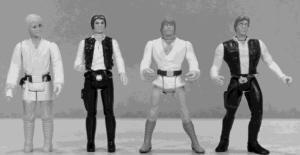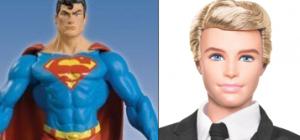As children, we are introduced to the world through colorful books and toys, through songs and small poems that make us figure out the so-complicated world. But what if these introductions have a side effect that can lead not to the desired discovery of the world, but to a false perception of what the world is really like.
In this article, we examine the role toys such as action figures or the Barbie doll have on our vision of the world and the way they teach us what is “masculine”, what is “feminine” and why many people don’t want to cross these clear lines.
When we are young, we are being introduced to the world and shown things in a representative way as what the standard and norm is. Children don’t relate so much to their adult parents as to what a man or a woman is, as due to their way of perceiving things, those adults are far away, but the toys they play with are a lot closer and easier to understand.
Just think about how parents or caretakers introduce toys to their children: “This is a car”, “this is a plane” etc. Kids come in contact with things not only through direct contact, such as seeing things and interacting with them, but also through another type of contact, and that is having representations of things on the computer and tablets, in games, on TV and in their hands. Action figures and toys in general can be used as a tool to analyze the evolution of cultural life and of body image.
Toys are not the only element that shape someone’s beliefs about body image and life, but they do have their contribution. For example, the first G.I. Joe figure, which appeared in 1964, had a waist that would be the equal 32-inches at human scale, along with 12-inch biceps. Several years after, in 1991 the figure’s waist had shrunk by three inches,but the biceps had gained four; therefore dramatically changing the waist-hip ration. By 1995, “GI Joe Extreme” figure had biceps nearly 27 inches around – larger than any bodybuilder ever known. The same thing happened to all characters, including Luke Skywalker and Han Solo; the toys based on these characters has similar proportions to the actors that had portrayed them, while the later versions were bigger than Schwarzenegger.

Luke Skywalker and Han Solo in 1978 (left); Luke Skywalker and Han Solo in1998 (right)
It’s definitely up for discussion whether these toys have any connection with the muscle dysmorphia condition, a disorder in which men are obsessed with their muscles to the point that they give up on having a social life or activities, in the favor of staying at the gym and working out. Another very common term associated with men and their body image is Body Dysmorphic Disorder, or BDD short. Men with BDD are also very preoccupied with the way they look and feel as if they are never strong and big enough. Useless to say that this leads to all sorts of problems, such as depression or anxiety. The concern seems to implemented in people from a very early age, giving the fact that statistically, most kids ask for a toy for Christmas.
Girls are also submitted to a weird standard, the Barbie doll. A extrapolated to a height of 67 inch (around 170 centimeter) Barbie doll would have a waist circumference of 16 inch (around 40 centimeter). What’s interesting to notice is that the female image in the toy world did not change so much over the years, as “boy’s toys” did. In 1997, the original Barbie doll received a small makeover, but her overall look did not change. If Barbie was a real life person, she would have anorexia and would not be able to function properly. Some studies have shown that studies have shown that exposure to images of Barbie dolls leads to an increase in body dissatisfaction in young girls.
In addition, there is the issue of why toys are separated by gender. There is a group called “Let Toys Be Toys” that asks retailers to stop classifying toys by gender. Even though boys are girls are treated as stereotypes since birth, going in a toy store is one of the first self-discriminating choices a kid makes: if he’s a boy he needs to go to the boy’s section and not look at the girl’s toys, or else he will be laughed at and left out.
To draw a clear line and see if the change of toy imagery has a direct correlation to BDD or other issues and trends in other types of media, would require more studies and research.
The separation of boys’ toys from girls’ toys does not only dictate who you must be, it also dictates what you need to do and act like. Everything in the girls’ toys department is pink: ovens, tea pots, horses, fairies, you know the type. Everything for boys is blue: planes, weapons, robots etc. Meanwhile, it’s interesting how the girls’ toys representing men, such as the infamous Ken doll, are not similar to what the boys’ toys representing men look like. In conclusion, boys are taught that men are a certain way and girls are taught that men are almost the complete opposite. Hmmm…

Most boys are either Superman nor Ken. And at times, boys who look like Ken want to be Superman and vice versa.
US network ABC has done a video experiment in which a woman was shopping with a boy that wanted to buy a fairy costume for Halloween, and later they redid the experiment with the mom shopping with a girl who wanted a Spiderman costume. The mom was supposed to act like she’s discontent with their child’s demand and the purpose of the experiment was to see with whom other parents would side. Besides one couple, everyone who interacted with the actors was telling the “mom” that she needs to “take care of it now” and convince her child that a boy has nothing to do in a fairy outfit and girl has nothing to do in a Spider-man costume. In the end, what are we afraid of? What are people so scared about? It’s a double answer: Parents fear that their kid will be laughed at, and it’s understandable that you wouldn’t want your child to be bullied, but, would you rather kill his personality and make him feel uncomfortable not only in school but at home as well? And then, there’s of course the big gay fear: people think that if a boy is into” girly” things or a girl is into “boyish” things, he or she will be gay. Besides the obvious “so what?”, we need to add that this mindset is not only false, but it is also hurtful and perpetuates aggressiveness and gender stereotypes.
You cannot destroy your kids personality because you fear that he or you will feel bad. It’s the abusers and the haters that need to be addressed, not a child trying to be who he or she is!
These things mostly go unnoticed, we don’t take the time to put the things we do into perspective, but it’s up to us to decide what we want to teach children and most important, what kind of example we want to set, because that is going to be stronger than any toy, any character and any book.
Fraquoh and Franchomme
P.S. What are your thoughts on these issues? Do you think children are being exposed to weird standards? Share your input below!

